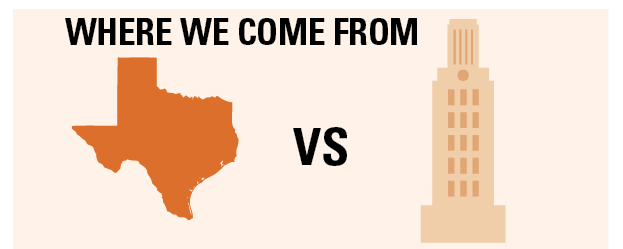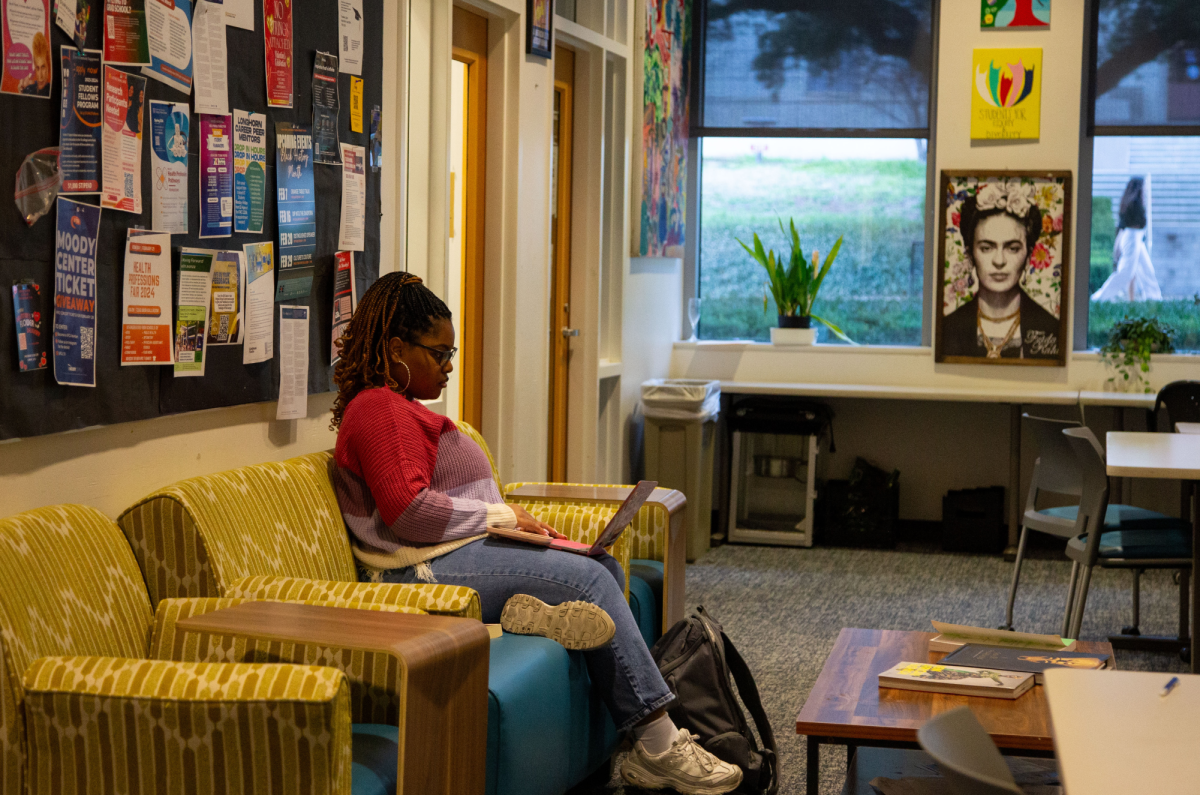Enrollment data shows the University looks a lot more like the rest of the state than it used to, but UT still struggles to diversify the socioeconomic and racial backgrounds of UT students.
On Oct. 10, the University will defend one aspect of its admissions process before the Supreme Court: the inclusion of race as a factor in considering applicants. The outcome of the case, Fisher v. University of Texas, will have implications for race-based affirmative action policies across the country. But race is only one element of campus diversity. Kedra Ishop, the vice provost and director of admissions, said diverse classes need students who come from a range of geographic regions, ethnicities, socioeconomic statuses and family education backgrounds.
“That’s really the role of a flagship institution: to be conscious of and strive toward that level of access for all students if they are prepared and if this is the institution they want to enroll in,” Ishop said.
Ishop said the University has diversified its student body in recent years, particularly increasing Latino enrollment. In 2010 the freshman class had more minority
students than white students for the first time. However, data still shows a disproportionate number of UT students come from white, urban and suburban, upper-middle class families.
WHERE WE COME FROM
According to a Dec. 2011 annual enrollment report to Gov. Rick Perry, 43 percent of the UT entering in-state students came from major suburban high schools, and 15 percent came from major urban high schools.
A further breakdown shows that of the 6,336 in-state freshman who came to UT in fall 2011, 23 percent came from the Houston area, 13 percent came from the Dallas area and 14 percent came from the Austin area. These numbers are in line with the distribution of the state’s patterns of school enrollment, according to Texas Education Agency documents.
Demographic equality for last year’s entering class of 6,336 in-state students ends there.
UT admissions data suggests having a parent who attended college proves a serious advantage for incoming students. According to census data, 25.8 percent of Texans aged 25 or older hold a bachelor’s degree or higher. Of students admitted to last year’s freshman class, 69 percent came from families with parents who earned a bachelor’s degree or higher. Four percent of those admitted had parents with an associate’s degree. First generation college students made up 23 percent of the class.
The gap reflects national trends, said Richard Reddick, assistant professor for educational administration. About 93 percent of students with college-educated parents attend college, and about 60 percent of students whose parents did not attend college pursue higher education, Reddick said.
First-generation college students do well at higher education institutions if they make it there, Reddick said.
“As a first-generation collegian myself, I want to make it clear that first-generation and low-income students are not necessarily less prepared academically, but they and their families often have less information available regarding issues such as college choice and financial aid,” Reddick said.
Lack of access to and knowledge about financial aid may lead to the socioeconomic gap between students who enroll at UT and those who don’t, Reddick said.
According to the U.S. Census Bureau, the median income for a Texas household between 2006 and 2010 was $49,646. Of in-state students admitted to UT in 2011, 46 percent came from households with incomes of greater than $100,000 per year. In comparison, 8 percent were admitted from families making less than $20,000 per year and 23 percent came from families making between $20,000 and $59,000.
Reddick described the socioeconomic gap as “pervasive” and attributed it to settlement patterns.
“[It] has much to do with residential segregation. We tend to live in neighborhoods that are racially and economically homogenous,” Reddick said.
At UT, students who are identified as white made up 45 percent of admitted in-state freshmen for 2011. This is comparable to census data that estimates 44.8 percent of the state’s population was white, non-Hispanic in 2011. Hispanics made up 25 percent of the same class, while they made up 38 percent of the state. Blacks made up 6 percent of the admitted class versus 12.2 percent of the state population. Asian students made up 19 percent of the class versus 4 percent of the state population.
HOW WE GOT HERE
State law mandates UT and all state universities automatically admit 75 percent of the freshman class based on students’ class rank. At UT that currently means students who rank in the top eight percent in high school will be automatically admitted. The remaining 25 percent of students are admitted under a process called “holistic review,” where standardized test scores, high school coursework, class rank, written essays, a resume, letters of recommendation and special circumstances are taken into account.
The gaps in race and socioeconomic status amplify among those admitted through holistic review rather than the automatic admissions law. Of holistic review admits in 2011, 58 percent of students were white and 61 percent came from families with income of more than $100,000.
“I thought UT would be very diverse before I got here,” said microbiology freshman Amee’ra Fuller, an African American student from Killeen. “And then I got here, and it wasn’t.”
Ishop said her office cannot compare applicants to state demographics during the admissions process because it would be illegal to set a quota of students with specific qualities.
“It’s not a process of quota and demographic-matching. It’s a process of trying to build this community of diversity so students can learn from one another,” Ishop said.
She said the University looks at its previous demographics to see how outreach and recruitment has helped diversify the campus.
“What we want to see is improvement, and we’ve seen a multitude of improvement over time, including this school year, in which we’re serving 24 percent of first-generation students and 30 percent low-income students [in the freshman class],” Ishop said.
The racial makeup at UT has become more proportional over time. In 1996 the in-state freshman class had 4 percent black students and 15 percent Hispanic students, 14 percent Asian students and 63 percent white students.
“The biggest challenge is perception,” Ishop said. “We’re a big institution. The perception is that we are inaccessible, that it’s impossible to get into UT, or they’ve heard it’s too hard. All of these are challenges to these groups of students we’re working to recruit. That’s why it’s important to get face time with these students in their communities.”
GETTING PAST PERCEPTION
Patrick Patterson, director of University Outreach Centers, acts as a liaison between higher education and students from traditionally under-served backgrounds.
Patterson and his staff provide information about college admissions, counseling, SAT preparation and essay writing assistance to high-achieving high school and middle school students who receive free or reduced lunch in the Austin Independent School District and fit the demographics of students who traditionally face barriers to entering higher education.
“Our goal is not necessarily for them to come to UT but just to go to college,” Patterson said. The UT Outreach-Austin program is one of five across the state. Other branches are in Dallas, Houston, San Antonio and Rio Grande Valley.
Eighty percent of last year’s graduating UT Outreach-Austin class matriculated to college, with 62 percent going to four-year institutions, Patterson said. This fall 23 alumni of the program enrolled in UT, and 15 went to the other UT System schools through the Coordinated Admissions Program, Patterson said. The UT Outreach-Austin program serves 500 to 600 middle school and high school students every year, Patterson said.
Exercise science freshman Wendoline Gamez said she would have been lost during the college application process without UT Outreach-Austin’s support.
“I would have never known about SAT prep or ACT prep,” Gamez said. “I would have been lost and nervous about whether I wanted to do this. Then I would have been overwhelmed by the cost and financial aid. I would have not wanted to further my education, because I was scared, because I didn’t know what to do.”
Once first-generation, rural and minority students and others get to UT, they can join the Gateway Scholars program for help making it through their freshman year. The program admits 300 freshman every year and provides academic support, priority registration and intense coaching through the first year at UT. The program recently expanded to include a four-year focus geared toward graduate and professional school training, Tiffany Tillis, director of initiatives and administrative services for the program, said.
“Our students come in, and they are performing on the same level as any other student on this campus, but for many of them the social capital is what is lacking,” Tillis said. “How to manage your time, how to study, how to take an exam — we want to expose them to tools to succeeding at this university. Navigating this institution is probably 50 percent of the battle.”
SCHOOLS HELPING THEIR STUDENTS
Rural and urban school districts around the state are learning how to give their students an extra edge against the largely white suburban schools that make up much of UT’s admitted class.
“In the rural schools, I think students have less opportunity to take the higher level classes that their suburban counterparts have, simply because it’s more difficult to attract instructors,” said Don Rogers, executive director of the Texas Rural Education Association.
Many rural schools are using distance learning and partnerships with community colleges that allow dual credit for high school and college-level courses to make their students more competitive, Rogers said.
At the urban level, school districts like Houston Independent School District have begun to instill college readiness very early.
Lupita Hinojosa, school services officer for Houston ISD, said the minority-majority district has a program where students are taught college readiness from the time they are in elementary schools. The program includes outreach efforts for their families.
“If you go into our kindergarten classes and ask our kids if they are going to college, nine times out of 10 they can tell you where they want to go,” Hinojosa said. “It’s usually the college of their teacher, but the influence is there.”
A number of large suburban high schools across the state have stopped ranking students outside the top 10 percent. This allows their students to avoid having low class rank counted against them in the holistic admissions process.
Westlake High School in Austin dropped its ranking system in 2010, Jeff Pilchiek, director of guidance counselors at the school, said.
“In regards to UT, we have had a lot of success in the last few years since we got rid of class rank,” Pilchiek said. “Class rank in a very competitive high school is not an accurate indicator of whether a student will do well in college or not, because their class ranks are so close to each other. You could be two ten-thousandth [of a GPA point] off and be in the bottom half of the class.”
In 2010, 93 Westlake students were admitted to UT. In 2011, after the school eliminated the ranking system, 142 students got into UT.
Pilchiek said eliminating class rank would not be a benefit in many Texas schools, which means each school has to tailor its system accordingly.
“If I went to another public high school in Texas, like in Brenham, Texas, with 250 kids, the class ranking system is going to advantage me more if I’m working hard,” Pilchiek said.
Meanwhile, UT continues to strive for diversity in its student body. Examining factors like race and socioeconomic background in holistic review advances this goal.
“We’re looking for high-achieving students from all over the state of Texas,” Ishop said. “Will they all get in? No. But we don’t read 35,000 applications to admit students from one group.”
WHAT’S NEXT? FISHER V. TEXAS
The Supreme Court will hear UT’s argument for its right to consider race in admissions next Wednesday in Fisher v. Texas.
Abigail Fisher, a white student who applied to UT and was denied admission, filed suit against the University for its use of race in the holistic admissions process along with another student in 2008. Fisher, now the sole plaintiff, claims the University’s use of race violates their right to equal protection under the 14th Amendment.
Race is one of seven factors the University considers special circumstances in the admissions process. Others include socioeconomic status, adversity and an applicant’s family responsibilities. The admissions department examines these elements along with academic achievement, such as standardized test scores and grades, as well as personal achievement, evaluated through resumes, recommendations and essays.
Reddick said the case is something every member of the UT community should care about.
“If we are in the business of preparing students to work and coexist in a diverse state, nation and world, we need every tool at our disposal to ensure that the college environment allows for true exposure to colleagues and peers that represent the cultural mosaic found in the workforce,” Reddick said.
The future of one major factor of UT’s cultural mosaic rests in the Supreme Court’s hands.

Printed on Friday, October 5, 2012 as: Race for higher education: UT works to diversity enrollment in face of legal battle





















